Literature Review: PECS and Autism Spectrum Disorder (ASD)
VerifiedAdded on 2022/12/29
|13
|4106
|98
Literature Review
AI Summary
This literature review explores the Picture Exchange Communication System (PECS) as an augmentative and alternative communication (AAC) method for individuals with Autism Spectrum Disorder (ASD). The review delves into the history and phases of PECS, highlighting its use in improving communication skills, particularly for those with limited or no spoken language. It examines teachers' and parents' perceptions of PECS, noting its effectiveness in educational and home settings, and addressing parental concerns regarding its impact on speech development. The review further discusses the positive impacts of PECS on children with ASD, emphasizing its role in enhancing functional communication skills and promoting social interaction. Various studies and research findings are cited, providing a comprehensive overview of PECS's application and outcomes in supporting individuals with autism.
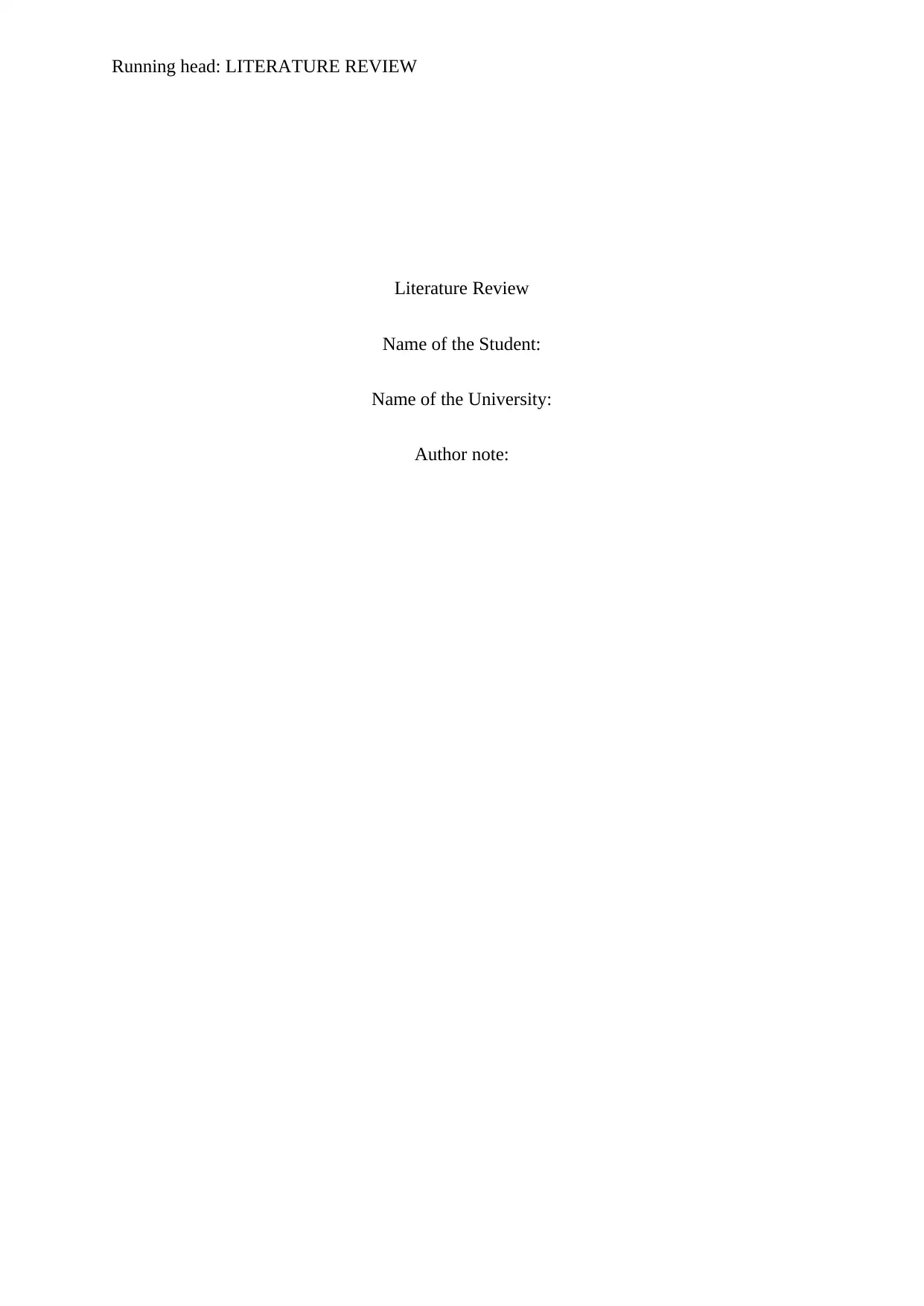
Running head: LITERATURE REVIEW
Literature Review
Name of the Student:
Name of the University:
Author note:
Literature Review
Name of the Student:
Name of the University:
Author note:
Paraphrase This Document
Need a fresh take? Get an instant paraphrase of this document with our AI Paraphraser
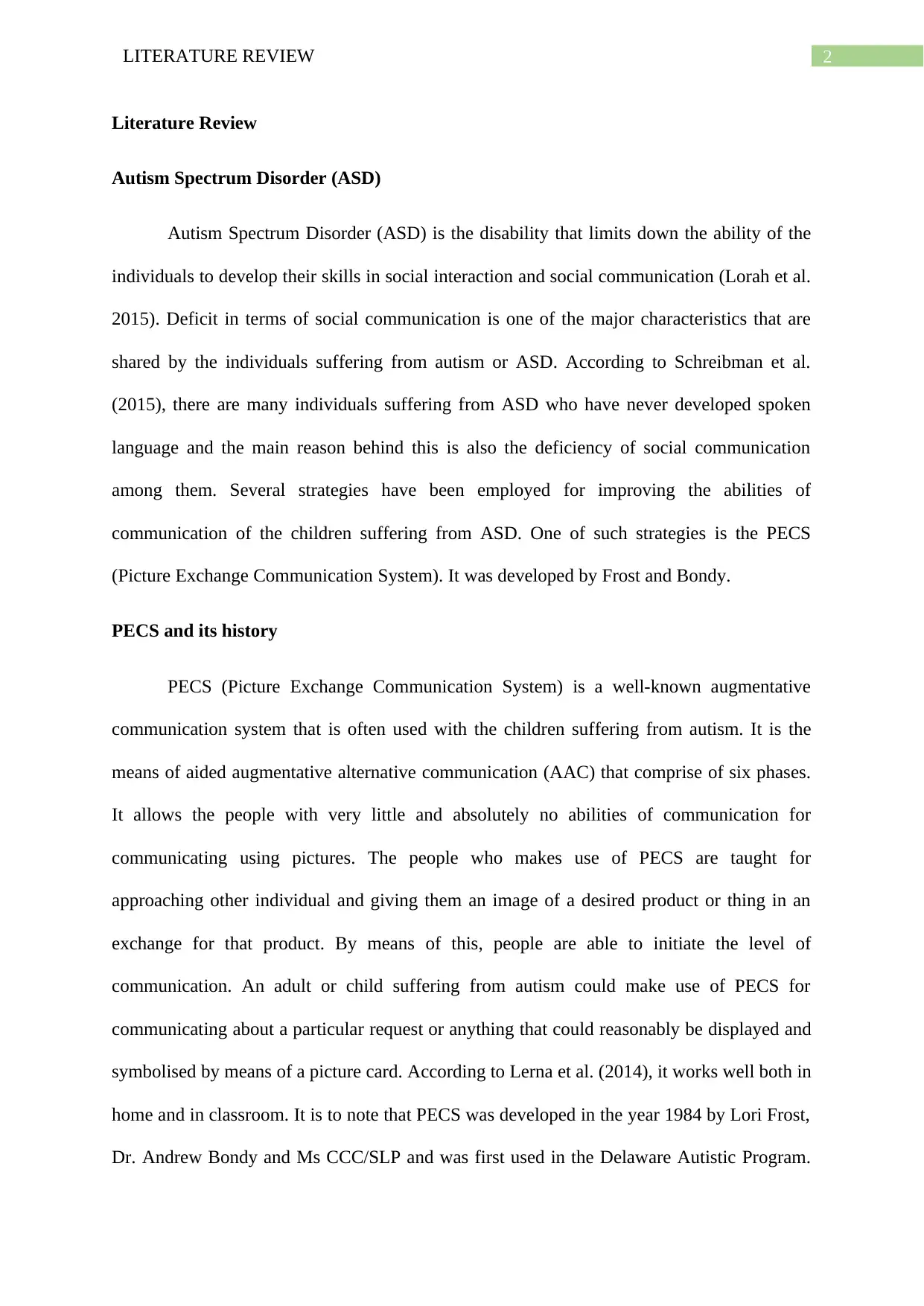
2LITERATURE REVIEW
Literature Review
Autism Spectrum Disorder (ASD)
Autism Spectrum Disorder (ASD) is the disability that limits down the ability of the
individuals to develop their skills in social interaction and social communication (Lorah et al.
2015). Deficit in terms of social communication is one of the major characteristics that are
shared by the individuals suffering from autism or ASD. According to Schreibman et al.
(2015), there are many individuals suffering from ASD who have never developed spoken
language and the main reason behind this is also the deficiency of social communication
among them. Several strategies have been employed for improving the abilities of
communication of the children suffering from ASD. One of such strategies is the PECS
(Picture Exchange Communication System). It was developed by Frost and Bondy.
PECS and its history
PECS (Picture Exchange Communication System) is a well-known augmentative
communication system that is often used with the children suffering from autism. It is the
means of aided augmentative alternative communication (AAC) that comprise of six phases.
It allows the people with very little and absolutely no abilities of communication for
communicating using pictures. The people who makes use of PECS are taught for
approaching other individual and giving them an image of a desired product or thing in an
exchange for that product. By means of this, people are able to initiate the level of
communication. An adult or child suffering from autism could make use of PECS for
communicating about a particular request or anything that could reasonably be displayed and
symbolised by means of a picture card. According to Lerna et al. (2014), it works well both in
home and in classroom. It is to note that PECS was developed in the year 1984 by Lori Frost,
Dr. Andrew Bondy and Ms CCC/SLP and was first used in the Delaware Autistic Program.
Literature Review
Autism Spectrum Disorder (ASD)
Autism Spectrum Disorder (ASD) is the disability that limits down the ability of the
individuals to develop their skills in social interaction and social communication (Lorah et al.
2015). Deficit in terms of social communication is one of the major characteristics that are
shared by the individuals suffering from autism or ASD. According to Schreibman et al.
(2015), there are many individuals suffering from ASD who have never developed spoken
language and the main reason behind this is also the deficiency of social communication
among them. Several strategies have been employed for improving the abilities of
communication of the children suffering from ASD. One of such strategies is the PECS
(Picture Exchange Communication System). It was developed by Frost and Bondy.
PECS and its history
PECS (Picture Exchange Communication System) is a well-known augmentative
communication system that is often used with the children suffering from autism. It is the
means of aided augmentative alternative communication (AAC) that comprise of six phases.
It allows the people with very little and absolutely no abilities of communication for
communicating using pictures. The people who makes use of PECS are taught for
approaching other individual and giving them an image of a desired product or thing in an
exchange for that product. By means of this, people are able to initiate the level of
communication. An adult or child suffering from autism could make use of PECS for
communicating about a particular request or anything that could reasonably be displayed and
symbolised by means of a picture card. According to Lerna et al. (2014), it works well both in
home and in classroom. It is to note that PECS was developed in the year 1984 by Lori Frost,
Dr. Andrew Bondy and Ms CCC/SLP and was first used in the Delaware Autistic Program.
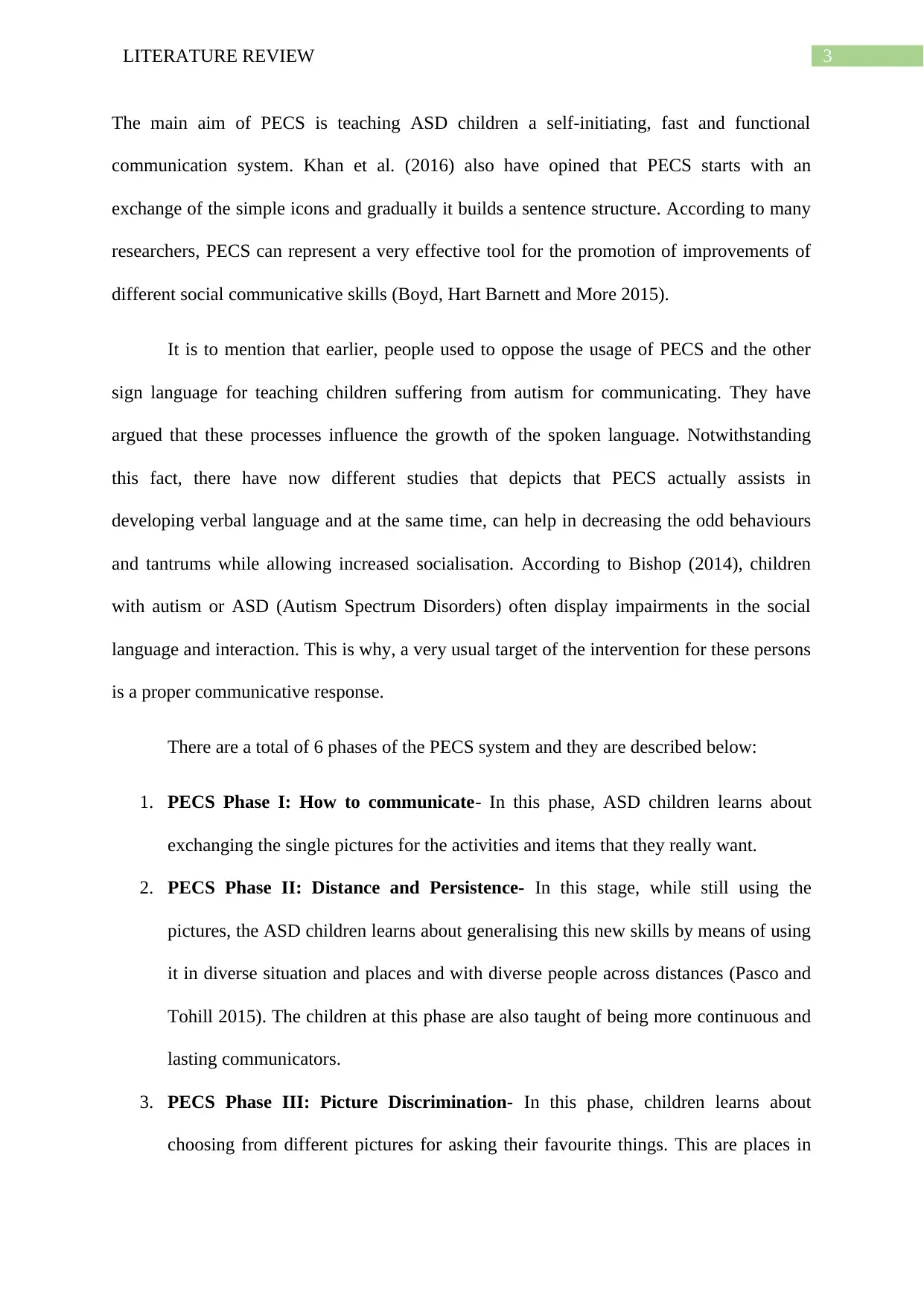
3LITERATURE REVIEW
The main aim of PECS is teaching ASD children a self-initiating, fast and functional
communication system. Khan et al. (2016) also have opined that PECS starts with an
exchange of the simple icons and gradually it builds a sentence structure. According to many
researchers, PECS can represent a very effective tool for the promotion of improvements of
different social communicative skills (Boyd, Hart Barnett and More 2015).
It is to mention that earlier, people used to oppose the usage of PECS and the other
sign language for teaching children suffering from autism for communicating. They have
argued that these processes influence the growth of the spoken language. Notwithstanding
this fact, there have now different studies that depicts that PECS actually assists in
developing verbal language and at the same time, can help in decreasing the odd behaviours
and tantrums while allowing increased socialisation. According to Bishop (2014), children
with autism or ASD (Autism Spectrum Disorders) often display impairments in the social
language and interaction. This is why, a very usual target of the intervention for these persons
is a proper communicative response.
There are a total of 6 phases of the PECS system and they are described below:
1. PECS Phase I: How to communicate- In this phase, ASD children learns about
exchanging the single pictures for the activities and items that they really want.
2. PECS Phase II: Distance and Persistence- In this stage, while still using the
pictures, the ASD children learns about generalising this new skills by means of using
it in diverse situation and places and with diverse people across distances (Pasco and
Tohill 2015). The children at this phase are also taught of being more continuous and
lasting communicators.
3. PECS Phase III: Picture Discrimination- In this phase, children learns about
choosing from different pictures for asking their favourite things. This are places in
The main aim of PECS is teaching ASD children a self-initiating, fast and functional
communication system. Khan et al. (2016) also have opined that PECS starts with an
exchange of the simple icons and gradually it builds a sentence structure. According to many
researchers, PECS can represent a very effective tool for the promotion of improvements of
different social communicative skills (Boyd, Hart Barnett and More 2015).
It is to mention that earlier, people used to oppose the usage of PECS and the other
sign language for teaching children suffering from autism for communicating. They have
argued that these processes influence the growth of the spoken language. Notwithstanding
this fact, there have now different studies that depicts that PECS actually assists in
developing verbal language and at the same time, can help in decreasing the odd behaviours
and tantrums while allowing increased socialisation. According to Bishop (2014), children
with autism or ASD (Autism Spectrum Disorders) often display impairments in the social
language and interaction. This is why, a very usual target of the intervention for these persons
is a proper communicative response.
There are a total of 6 phases of the PECS system and they are described below:
1. PECS Phase I: How to communicate- In this phase, ASD children learns about
exchanging the single pictures for the activities and items that they really want.
2. PECS Phase II: Distance and Persistence- In this stage, while still using the
pictures, the ASD children learns about generalising this new skills by means of using
it in diverse situation and places and with diverse people across distances (Pasco and
Tohill 2015). The children at this phase are also taught of being more continuous and
lasting communicators.
3. PECS Phase III: Picture Discrimination- In this phase, children learns about
choosing from different pictures for asking their favourite things. This are places in
⊘ This is a preview!⊘
Do you want full access?
Subscribe today to unlock all pages.

Trusted by 1+ million students worldwide
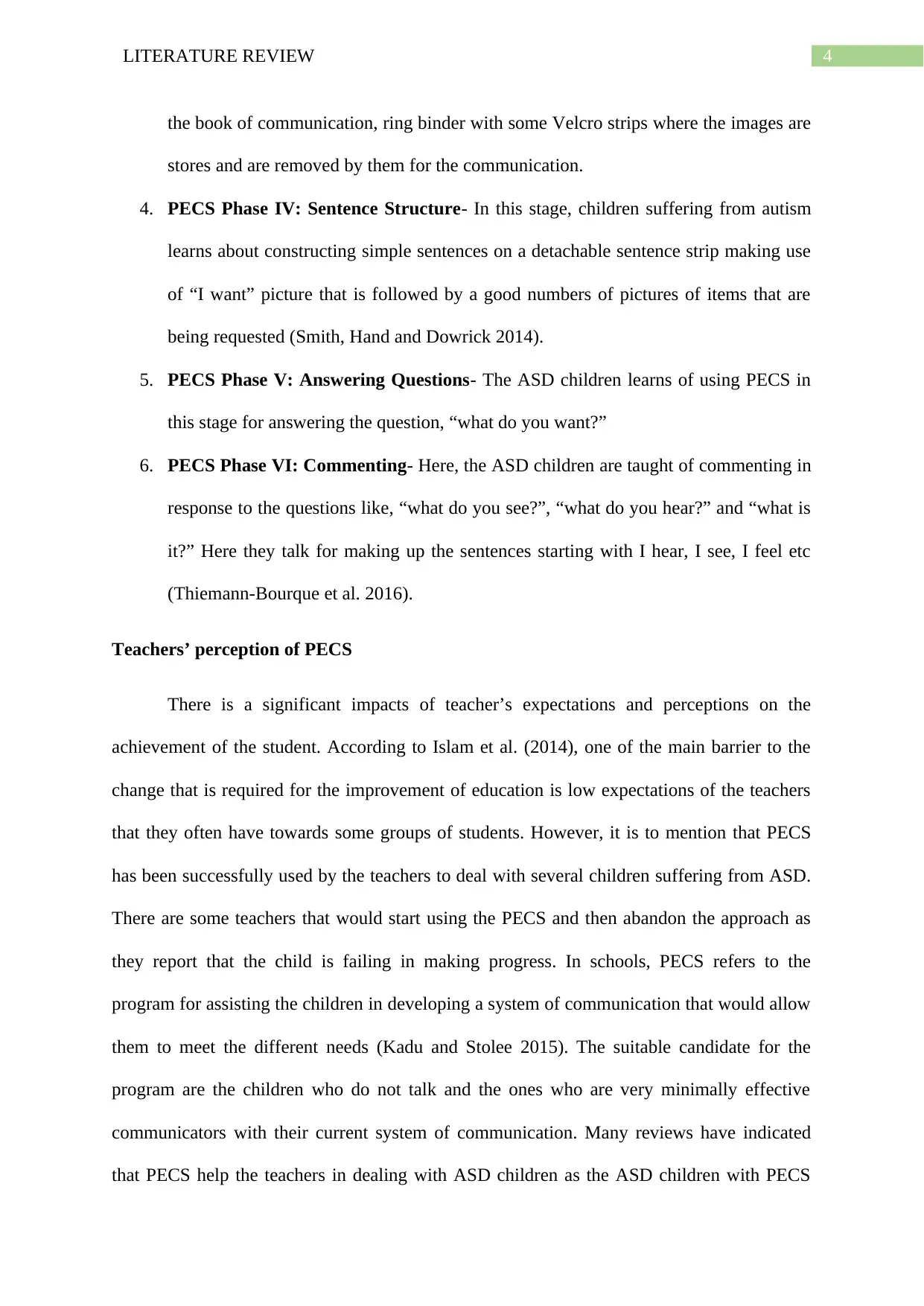
4LITERATURE REVIEW
the book of communication, ring binder with some Velcro strips where the images are
stores and are removed by them for the communication.
4. PECS Phase IV: Sentence Structure- In this stage, children suffering from autism
learns about constructing simple sentences on a detachable sentence strip making use
of “I want” picture that is followed by a good numbers of pictures of items that are
being requested (Smith, Hand and Dowrick 2014).
5. PECS Phase V: Answering Questions- The ASD children learns of using PECS in
this stage for answering the question, “what do you want?”
6. PECS Phase VI: Commenting- Here, the ASD children are taught of commenting in
response to the questions like, “what do you see?”, “what do you hear?” and “what is
it?” Here they talk for making up the sentences starting with I hear, I see, I feel etc
(Thiemann-Bourque et al. 2016).
Teachers’ perception of PECS
There is a significant impacts of teacher’s expectations and perceptions on the
achievement of the student. According to Islam et al. (2014), one of the main barrier to the
change that is required for the improvement of education is low expectations of the teachers
that they often have towards some groups of students. However, it is to mention that PECS
has been successfully used by the teachers to deal with several children suffering from ASD.
There are some teachers that would start using the PECS and then abandon the approach as
they report that the child is failing in making progress. In schools, PECS refers to the
program for assisting the children in developing a system of communication that would allow
them to meet the different needs (Kadu and Stolee 2015). The suitable candidate for the
program are the children who do not talk and the ones who are very minimally effective
communicators with their current system of communication. Many reviews have indicated
that PECS help the teachers in dealing with ASD children as the ASD children with PECS
the book of communication, ring binder with some Velcro strips where the images are
stores and are removed by them for the communication.
4. PECS Phase IV: Sentence Structure- In this stage, children suffering from autism
learns about constructing simple sentences on a detachable sentence strip making use
of “I want” picture that is followed by a good numbers of pictures of items that are
being requested (Smith, Hand and Dowrick 2014).
5. PECS Phase V: Answering Questions- The ASD children learns of using PECS in
this stage for answering the question, “what do you want?”
6. PECS Phase VI: Commenting- Here, the ASD children are taught of commenting in
response to the questions like, “what do you see?”, “what do you hear?” and “what is
it?” Here they talk for making up the sentences starting with I hear, I see, I feel etc
(Thiemann-Bourque et al. 2016).
Teachers’ perception of PECS
There is a significant impacts of teacher’s expectations and perceptions on the
achievement of the student. According to Islam et al. (2014), one of the main barrier to the
change that is required for the improvement of education is low expectations of the teachers
that they often have towards some groups of students. However, it is to mention that PECS
has been successfully used by the teachers to deal with several children suffering from ASD.
There are some teachers that would start using the PECS and then abandon the approach as
they report that the child is failing in making progress. In schools, PECS refers to the
program for assisting the children in developing a system of communication that would allow
them to meet the different needs (Kadu and Stolee 2015). The suitable candidate for the
program are the children who do not talk and the ones who are very minimally effective
communicators with their current system of communication. Many reviews have indicated
that PECS help the teachers in dealing with ASD children as the ASD children with PECS
Paraphrase This Document
Need a fresh take? Get an instant paraphrase of this document with our AI Paraphraser
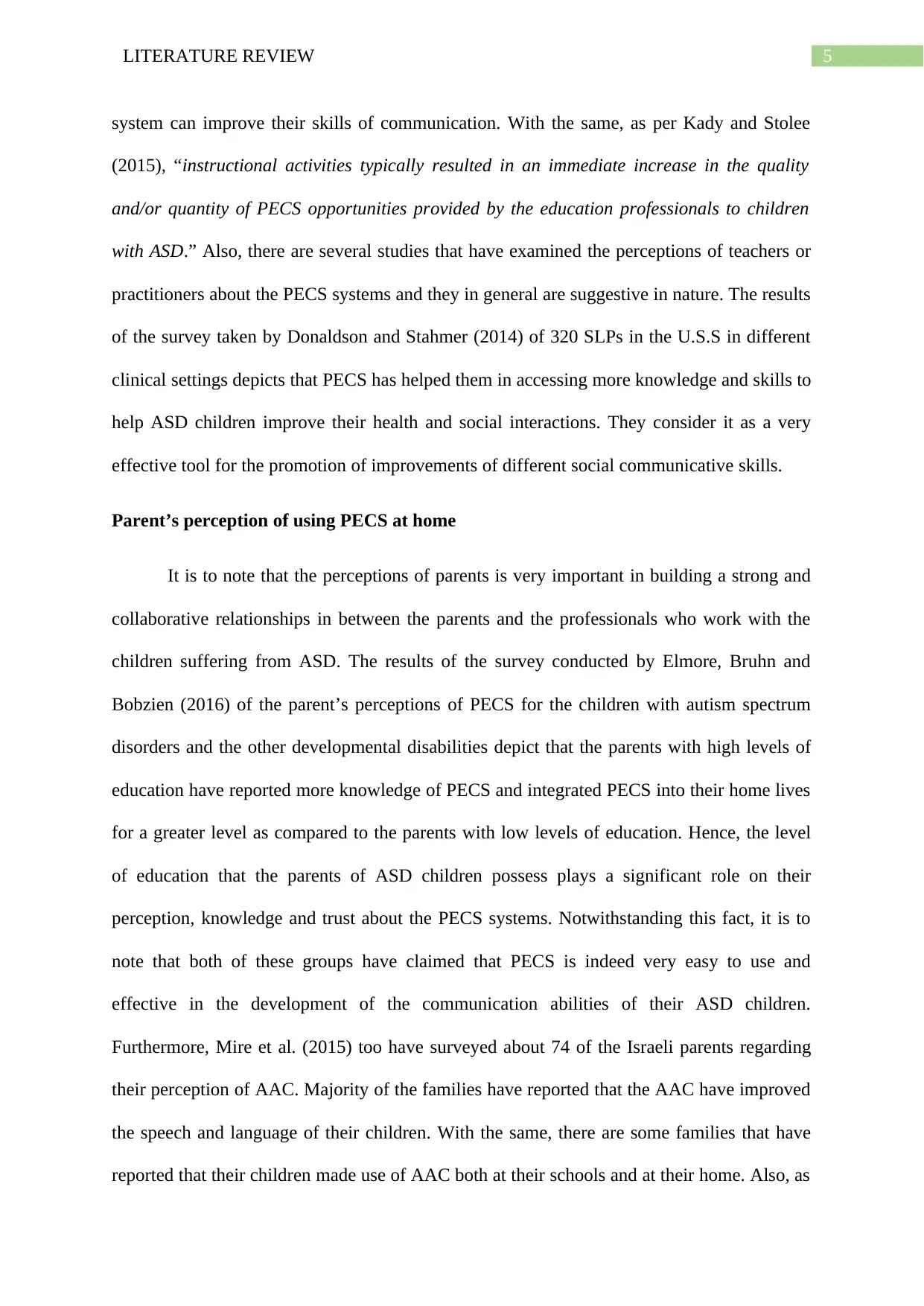
5LITERATURE REVIEW
system can improve their skills of communication. With the same, as per Kady and Stolee
(2015), “instructional activities typically resulted in an immediate increase in the quality
and/or quantity of PECS opportunities provided by the education professionals to children
with ASD.” Also, there are several studies that have examined the perceptions of teachers or
practitioners about the PECS systems and they in general are suggestive in nature. The results
of the survey taken by Donaldson and Stahmer (2014) of 320 SLPs in the U.S.S in different
clinical settings depicts that PECS has helped them in accessing more knowledge and skills to
help ASD children improve their health and social interactions. They consider it as a very
effective tool for the promotion of improvements of different social communicative skills.
Parent’s perception of using PECS at home
It is to note that the perceptions of parents is very important in building a strong and
collaborative relationships in between the parents and the professionals who work with the
children suffering from ASD. The results of the survey conducted by Elmore, Bruhn and
Bobzien (2016) of the parent’s perceptions of PECS for the children with autism spectrum
disorders and the other developmental disabilities depict that the parents with high levels of
education have reported more knowledge of PECS and integrated PECS into their home lives
for a greater level as compared to the parents with low levels of education. Hence, the level
of education that the parents of ASD children possess plays a significant role on their
perception, knowledge and trust about the PECS systems. Notwithstanding this fact, it is to
note that both of these groups have claimed that PECS is indeed very easy to use and
effective in the development of the communication abilities of their ASD children.
Furthermore, Mire et al. (2015) too have surveyed about 74 of the Israeli parents regarding
their perception of AAC. Majority of the families have reported that the AAC have improved
the speech and language of their children. With the same, there are some families that have
reported that their children made use of AAC both at their schools and at their home. Also, as
system can improve their skills of communication. With the same, as per Kady and Stolee
(2015), “instructional activities typically resulted in an immediate increase in the quality
and/or quantity of PECS opportunities provided by the education professionals to children
with ASD.” Also, there are several studies that have examined the perceptions of teachers or
practitioners about the PECS systems and they in general are suggestive in nature. The results
of the survey taken by Donaldson and Stahmer (2014) of 320 SLPs in the U.S.S in different
clinical settings depicts that PECS has helped them in accessing more knowledge and skills to
help ASD children improve their health and social interactions. They consider it as a very
effective tool for the promotion of improvements of different social communicative skills.
Parent’s perception of using PECS at home
It is to note that the perceptions of parents is very important in building a strong and
collaborative relationships in between the parents and the professionals who work with the
children suffering from ASD. The results of the survey conducted by Elmore, Bruhn and
Bobzien (2016) of the parent’s perceptions of PECS for the children with autism spectrum
disorders and the other developmental disabilities depict that the parents with high levels of
education have reported more knowledge of PECS and integrated PECS into their home lives
for a greater level as compared to the parents with low levels of education. Hence, the level
of education that the parents of ASD children possess plays a significant role on their
perception, knowledge and trust about the PECS systems. Notwithstanding this fact, it is to
note that both of these groups have claimed that PECS is indeed very easy to use and
effective in the development of the communication abilities of their ASD children.
Furthermore, Mire et al. (2015) too have surveyed about 74 of the Israeli parents regarding
their perception of AAC. Majority of the families have reported that the AAC have improved
the speech and language of their children. With the same, there are some families that have
reported that their children made use of AAC both at their schools and at their home. Also, as
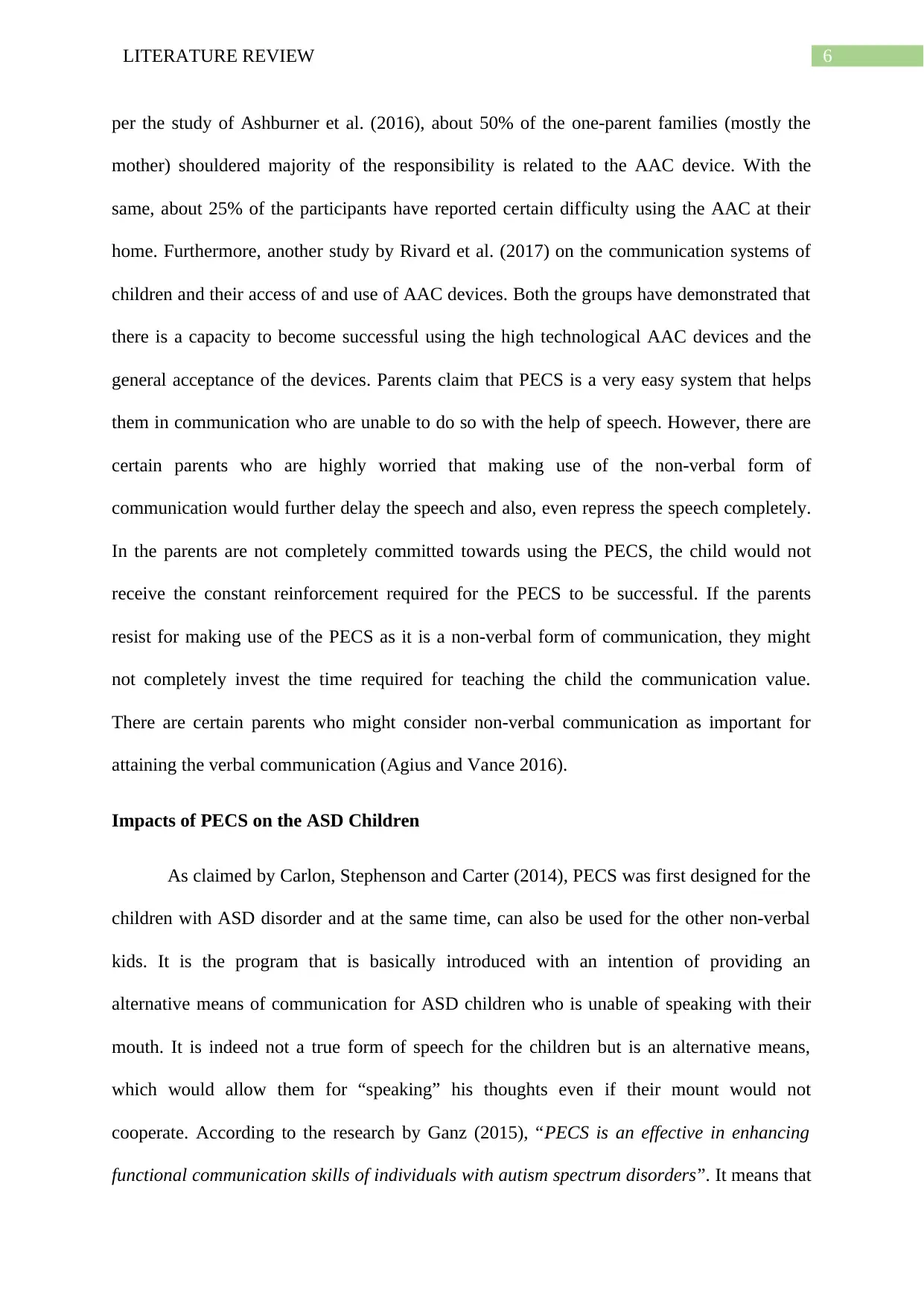
6LITERATURE REVIEW
per the study of Ashburner et al. (2016), about 50% of the one-parent families (mostly the
mother) shouldered majority of the responsibility is related to the AAC device. With the
same, about 25% of the participants have reported certain difficulty using the AAC at their
home. Furthermore, another study by Rivard et al. (2017) on the communication systems of
children and their access of and use of AAC devices. Both the groups have demonstrated that
there is a capacity to become successful using the high technological AAC devices and the
general acceptance of the devices. Parents claim that PECS is a very easy system that helps
them in communication who are unable to do so with the help of speech. However, there are
certain parents who are highly worried that making use of the non-verbal form of
communication would further delay the speech and also, even repress the speech completely.
In the parents are not completely committed towards using the PECS, the child would not
receive the constant reinforcement required for the PECS to be successful. If the parents
resist for making use of the PECS as it is a non-verbal form of communication, they might
not completely invest the time required for teaching the child the communication value.
There are certain parents who might consider non-verbal communication as important for
attaining the verbal communication (Agius and Vance 2016).
Impacts of PECS on the ASD Children
As claimed by Carlon, Stephenson and Carter (2014), PECS was first designed for the
children with ASD disorder and at the same time, can also be used for the other non-verbal
kids. It is the program that is basically introduced with an intention of providing an
alternative means of communication for ASD children who is unable of speaking with their
mouth. It is indeed not a true form of speech for the children but is an alternative means,
which would allow them for “speaking” his thoughts even if their mount would not
cooperate. According to the research by Ganz (2015), “PECS is an effective in enhancing
functional communication skills of individuals with autism spectrum disorders”. It means that
per the study of Ashburner et al. (2016), about 50% of the one-parent families (mostly the
mother) shouldered majority of the responsibility is related to the AAC device. With the
same, about 25% of the participants have reported certain difficulty using the AAC at their
home. Furthermore, another study by Rivard et al. (2017) on the communication systems of
children and their access of and use of AAC devices. Both the groups have demonstrated that
there is a capacity to become successful using the high technological AAC devices and the
general acceptance of the devices. Parents claim that PECS is a very easy system that helps
them in communication who are unable to do so with the help of speech. However, there are
certain parents who are highly worried that making use of the non-verbal form of
communication would further delay the speech and also, even repress the speech completely.
In the parents are not completely committed towards using the PECS, the child would not
receive the constant reinforcement required for the PECS to be successful. If the parents
resist for making use of the PECS as it is a non-verbal form of communication, they might
not completely invest the time required for teaching the child the communication value.
There are certain parents who might consider non-verbal communication as important for
attaining the verbal communication (Agius and Vance 2016).
Impacts of PECS on the ASD Children
As claimed by Carlon, Stephenson and Carter (2014), PECS was first designed for the
children with ASD disorder and at the same time, can also be used for the other non-verbal
kids. It is the program that is basically introduced with an intention of providing an
alternative means of communication for ASD children who is unable of speaking with their
mouth. It is indeed not a true form of speech for the children but is an alternative means,
which would allow them for “speaking” his thoughts even if their mount would not
cooperate. According to the research by Ganz (2015), “PECS is an effective in enhancing
functional communication skills of individuals with autism spectrum disorders”. It means that
⊘ This is a preview!⊘
Do you want full access?
Subscribe today to unlock all pages.

Trusted by 1+ million students worldwide
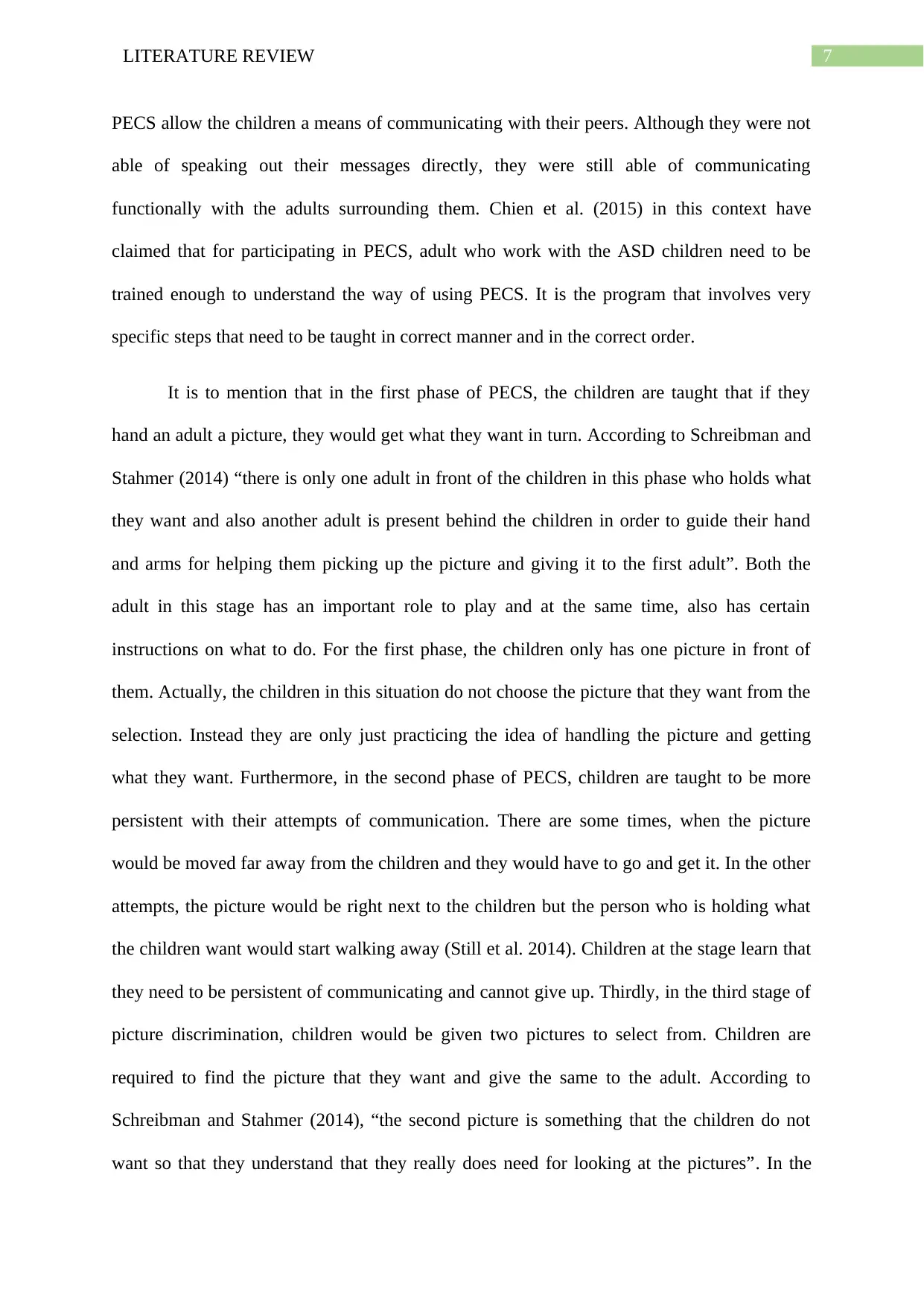
7LITERATURE REVIEW
PECS allow the children a means of communicating with their peers. Although they were not
able of speaking out their messages directly, they were still able of communicating
functionally with the adults surrounding them. Chien et al. (2015) in this context have
claimed that for participating in PECS, adult who work with the ASD children need to be
trained enough to understand the way of using PECS. It is the program that involves very
specific steps that need to be taught in correct manner and in the correct order.
It is to mention that in the first phase of PECS, the children are taught that if they
hand an adult a picture, they would get what they want in turn. According to Schreibman and
Stahmer (2014) “there is only one adult in front of the children in this phase who holds what
they want and also another adult is present behind the children in order to guide their hand
and arms for helping them picking up the picture and giving it to the first adult”. Both the
adult in this stage has an important role to play and at the same time, also has certain
instructions on what to do. For the first phase, the children only has one picture in front of
them. Actually, the children in this situation do not choose the picture that they want from the
selection. Instead they are only just practicing the idea of handling the picture and getting
what they want. Furthermore, in the second phase of PECS, children are taught to be more
persistent with their attempts of communication. There are some times, when the picture
would be moved far away from the children and they would have to go and get it. In the other
attempts, the picture would be right next to the children but the person who is holding what
the children want would start walking away (Still et al. 2014). Children at the stage learn that
they need to be persistent of communicating and cannot give up. Thirdly, in the third stage of
picture discrimination, children would be given two pictures to select from. Children are
required to find the picture that they want and give the same to the adult. According to
Schreibman and Stahmer (2014), “the second picture is something that the children do not
want so that they understand that they really does need for looking at the pictures”. In the
PECS allow the children a means of communicating with their peers. Although they were not
able of speaking out their messages directly, they were still able of communicating
functionally with the adults surrounding them. Chien et al. (2015) in this context have
claimed that for participating in PECS, adult who work with the ASD children need to be
trained enough to understand the way of using PECS. It is the program that involves very
specific steps that need to be taught in correct manner and in the correct order.
It is to mention that in the first phase of PECS, the children are taught that if they
hand an adult a picture, they would get what they want in turn. According to Schreibman and
Stahmer (2014) “there is only one adult in front of the children in this phase who holds what
they want and also another adult is present behind the children in order to guide their hand
and arms for helping them picking up the picture and giving it to the first adult”. Both the
adult in this stage has an important role to play and at the same time, also has certain
instructions on what to do. For the first phase, the children only has one picture in front of
them. Actually, the children in this situation do not choose the picture that they want from the
selection. Instead they are only just practicing the idea of handling the picture and getting
what they want. Furthermore, in the second phase of PECS, children are taught to be more
persistent with their attempts of communication. There are some times, when the picture
would be moved far away from the children and they would have to go and get it. In the other
attempts, the picture would be right next to the children but the person who is holding what
the children want would start walking away (Still et al. 2014). Children at the stage learn that
they need to be persistent of communicating and cannot give up. Thirdly, in the third stage of
picture discrimination, children would be given two pictures to select from. Children are
required to find the picture that they want and give the same to the adult. According to
Schreibman and Stahmer (2014), “the second picture is something that the children do not
want so that they understand that they really does need for looking at the pictures”. In the
Paraphrase This Document
Need a fresh take? Get an instant paraphrase of this document with our AI Paraphraser
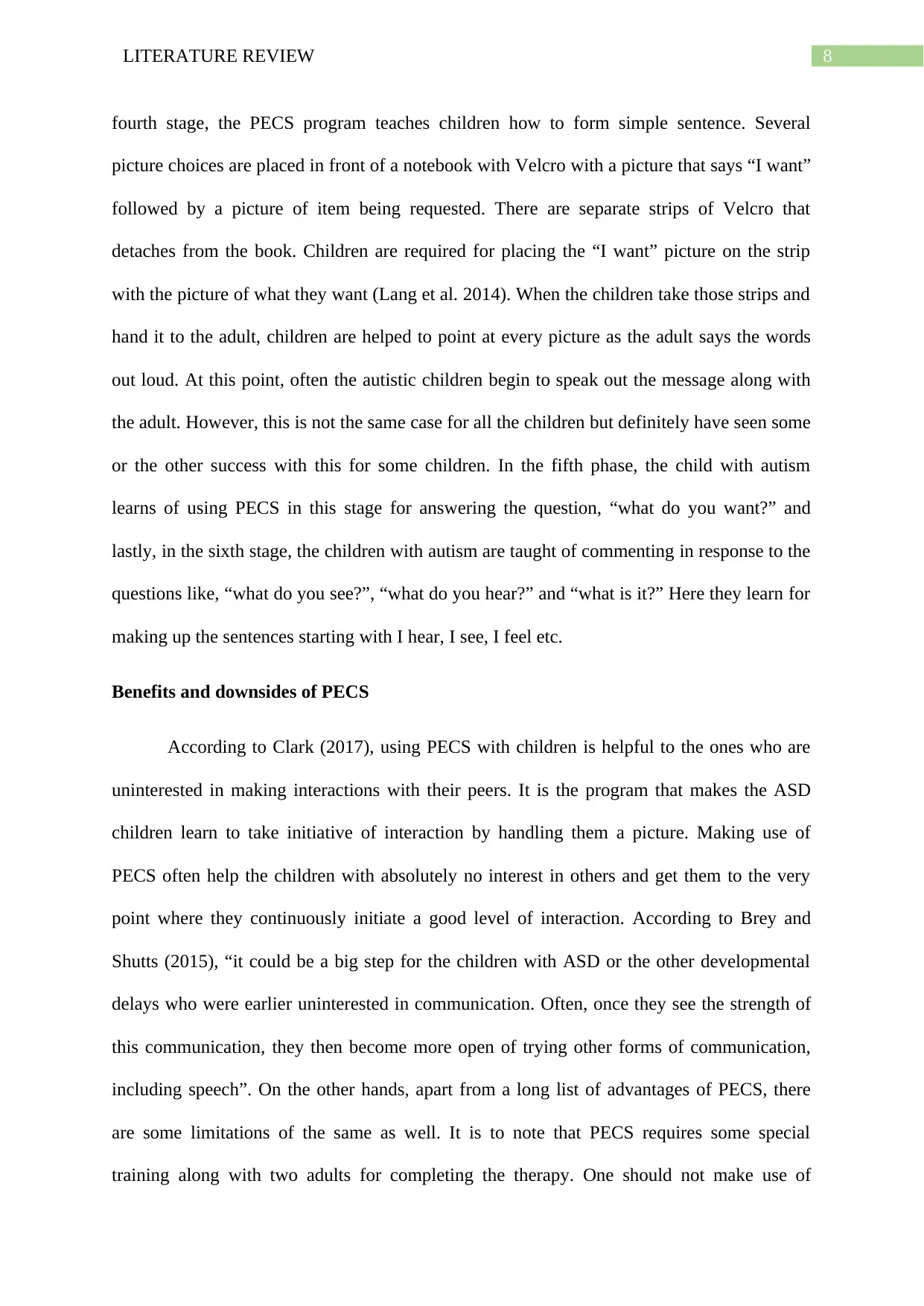
8LITERATURE REVIEW
fourth stage, the PECS program teaches children how to form simple sentence. Several
picture choices are placed in front of a notebook with Velcro with a picture that says “I want”
followed by a picture of item being requested. There are separate strips of Velcro that
detaches from the book. Children are required for placing the “I want” picture on the strip
with the picture of what they want (Lang et al. 2014). When the children take those strips and
hand it to the adult, children are helped to point at every picture as the adult says the words
out loud. At this point, often the autistic children begin to speak out the message along with
the adult. However, this is not the same case for all the children but definitely have seen some
or the other success with this for some children. In the fifth phase, the child with autism
learns of using PECS in this stage for answering the question, “what do you want?” and
lastly, in the sixth stage, the children with autism are taught of commenting in response to the
questions like, “what do you see?”, “what do you hear?” and “what is it?” Here they learn for
making up the sentences starting with I hear, I see, I feel etc.
Benefits and downsides of PECS
According to Clark (2017), using PECS with children is helpful to the ones who are
uninterested in making interactions with their peers. It is the program that makes the ASD
children learn to take initiative of interaction by handling them a picture. Making use of
PECS often help the children with absolutely no interest in others and get them to the very
point where they continuously initiate a good level of interaction. According to Brey and
Shutts (2015), “it could be a big step for the children with ASD or the other developmental
delays who were earlier uninterested in communication. Often, once they see the strength of
this communication, they then become more open of trying other forms of communication,
including speech”. On the other hands, apart from a long list of advantages of PECS, there
are some limitations of the same as well. It is to note that PECS requires some special
training along with two adults for completing the therapy. One should not make use of
fourth stage, the PECS program teaches children how to form simple sentence. Several
picture choices are placed in front of a notebook with Velcro with a picture that says “I want”
followed by a picture of item being requested. There are separate strips of Velcro that
detaches from the book. Children are required for placing the “I want” picture on the strip
with the picture of what they want (Lang et al. 2014). When the children take those strips and
hand it to the adult, children are helped to point at every picture as the adult says the words
out loud. At this point, often the autistic children begin to speak out the message along with
the adult. However, this is not the same case for all the children but definitely have seen some
or the other success with this for some children. In the fifth phase, the child with autism
learns of using PECS in this stage for answering the question, “what do you want?” and
lastly, in the sixth stage, the children with autism are taught of commenting in response to the
questions like, “what do you see?”, “what do you hear?” and “what is it?” Here they learn for
making up the sentences starting with I hear, I see, I feel etc.
Benefits and downsides of PECS
According to Clark (2017), using PECS with children is helpful to the ones who are
uninterested in making interactions with their peers. It is the program that makes the ASD
children learn to take initiative of interaction by handling them a picture. Making use of
PECS often help the children with absolutely no interest in others and get them to the very
point where they continuously initiate a good level of interaction. According to Brey and
Shutts (2015), “it could be a big step for the children with ASD or the other developmental
delays who were earlier uninterested in communication. Often, once they see the strength of
this communication, they then become more open of trying other forms of communication,
including speech”. On the other hands, apart from a long list of advantages of PECS, there
are some limitations of the same as well. It is to note that PECS requires some special
training along with two adults for completing the therapy. One should not make use of

9LITERATURE REVIEW
materials if one have not been trained and it could often be very tough to find out two adults
working on this at the same time (Schreibman and Stahmer 2014). It could be especially hard
if one is an SLP working in a school in absence of a huge number of different supports and if
the one is a parent at home without any other adult present for supporting, majority of the
time.
materials if one have not been trained and it could often be very tough to find out two adults
working on this at the same time (Schreibman and Stahmer 2014). It could be especially hard
if one is an SLP working in a school in absence of a huge number of different supports and if
the one is a parent at home without any other adult present for supporting, majority of the
time.
⊘ This is a preview!⊘
Do you want full access?
Subscribe today to unlock all pages.

Trusted by 1+ million students worldwide
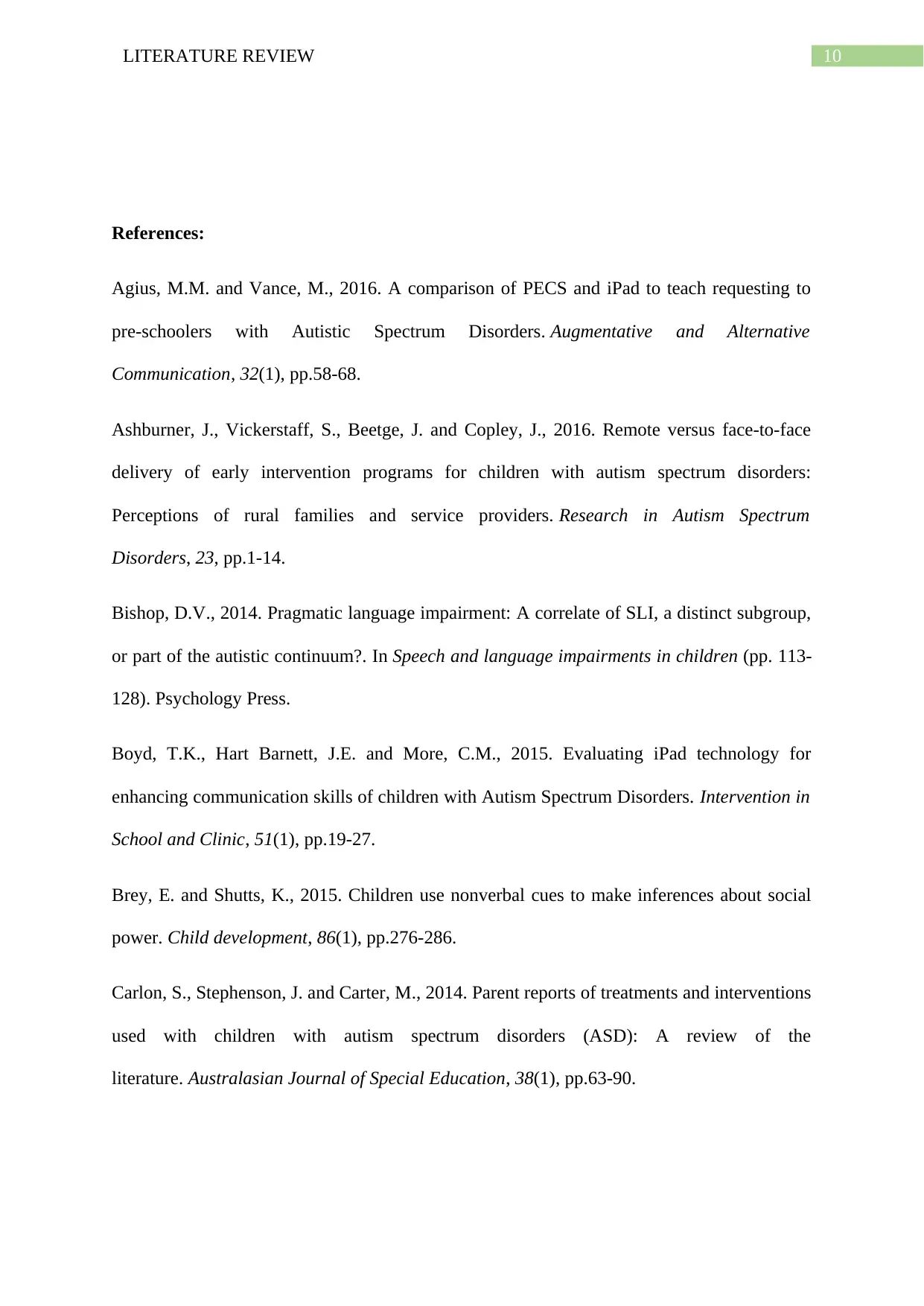
10LITERATURE REVIEW
References:
Agius, M.M. and Vance, M., 2016. A comparison of PECS and iPad to teach requesting to
pre-schoolers with Autistic Spectrum Disorders. Augmentative and Alternative
Communication, 32(1), pp.58-68.
Ashburner, J., Vickerstaff, S., Beetge, J. and Copley, J., 2016. Remote versus face-to-face
delivery of early intervention programs for children with autism spectrum disorders:
Perceptions of rural families and service providers. Research in Autism Spectrum
Disorders, 23, pp.1-14.
Bishop, D.V., 2014. Pragmatic language impairment: A correlate of SLI, a distinct subgroup,
or part of the autistic continuum?. In Speech and language impairments in children (pp. 113-
128). Psychology Press.
Boyd, T.K., Hart Barnett, J.E. and More, C.M., 2015. Evaluating iPad technology for
enhancing communication skills of children with Autism Spectrum Disorders. Intervention in
School and Clinic, 51(1), pp.19-27.
Brey, E. and Shutts, K., 2015. Children use nonverbal cues to make inferences about social
power. Child development, 86(1), pp.276-286.
Carlon, S., Stephenson, J. and Carter, M., 2014. Parent reports of treatments and interventions
used with children with autism spectrum disorders (ASD): A review of the
literature. Australasian Journal of Special Education, 38(1), pp.63-90.
References:
Agius, M.M. and Vance, M., 2016. A comparison of PECS and iPad to teach requesting to
pre-schoolers with Autistic Spectrum Disorders. Augmentative and Alternative
Communication, 32(1), pp.58-68.
Ashburner, J., Vickerstaff, S., Beetge, J. and Copley, J., 2016. Remote versus face-to-face
delivery of early intervention programs for children with autism spectrum disorders:
Perceptions of rural families and service providers. Research in Autism Spectrum
Disorders, 23, pp.1-14.
Bishop, D.V., 2014. Pragmatic language impairment: A correlate of SLI, a distinct subgroup,
or part of the autistic continuum?. In Speech and language impairments in children (pp. 113-
128). Psychology Press.
Boyd, T.K., Hart Barnett, J.E. and More, C.M., 2015. Evaluating iPad technology for
enhancing communication skills of children with Autism Spectrum Disorders. Intervention in
School and Clinic, 51(1), pp.19-27.
Brey, E. and Shutts, K., 2015. Children use nonverbal cues to make inferences about social
power. Child development, 86(1), pp.276-286.
Carlon, S., Stephenson, J. and Carter, M., 2014. Parent reports of treatments and interventions
used with children with autism spectrum disorders (ASD): A review of the
literature. Australasian Journal of Special Education, 38(1), pp.63-90.
Paraphrase This Document
Need a fresh take? Get an instant paraphrase of this document with our AI Paraphraser
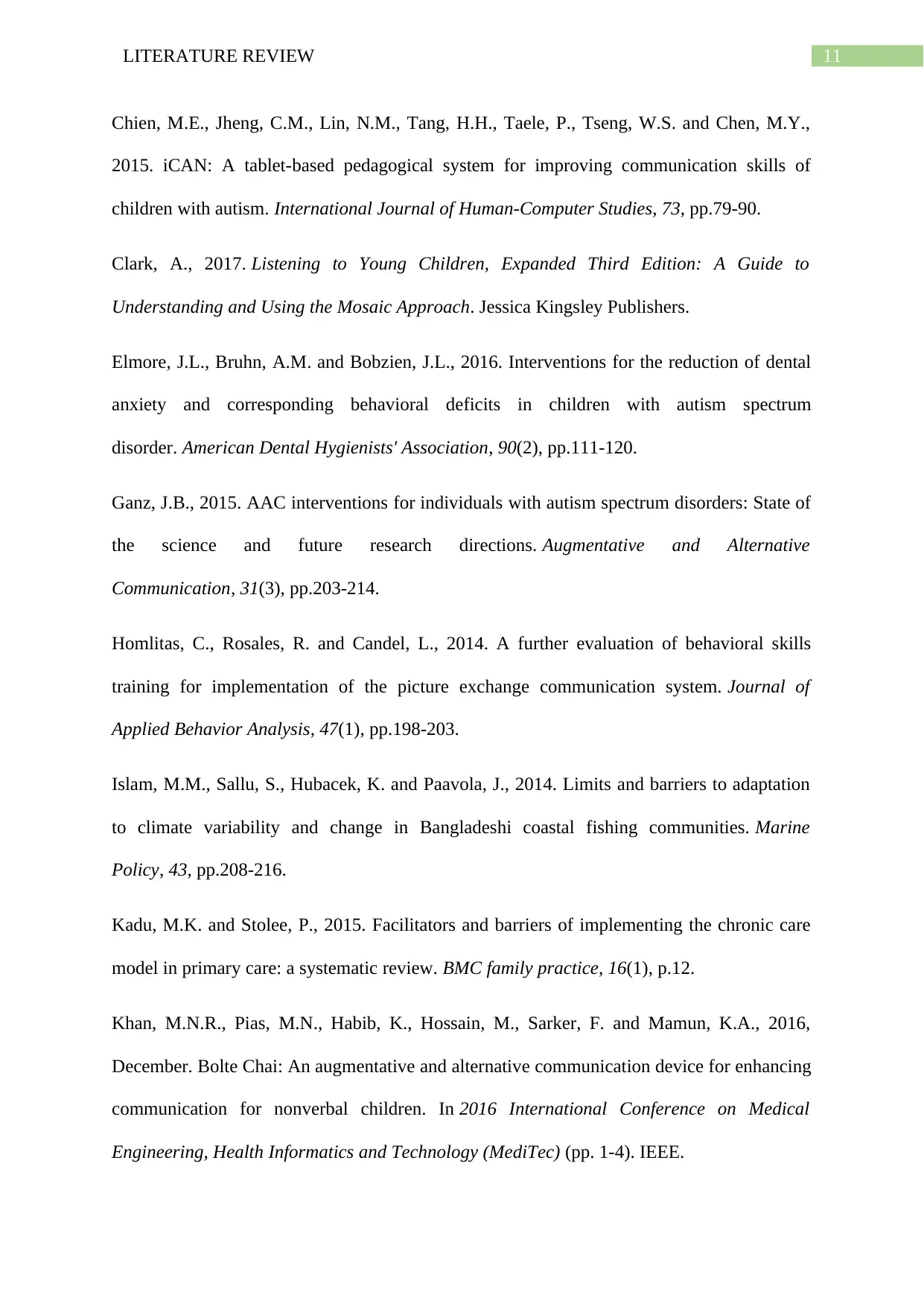
11LITERATURE REVIEW
Chien, M.E., Jheng, C.M., Lin, N.M., Tang, H.H., Taele, P., Tseng, W.S. and Chen, M.Y.,
2015. iCAN: A tablet-based pedagogical system for improving communication skills of
children with autism. International Journal of Human-Computer Studies, 73, pp.79-90.
Clark, A., 2017. Listening to Young Children, Expanded Third Edition: A Guide to
Understanding and Using the Mosaic Approach. Jessica Kingsley Publishers.
Elmore, J.L., Bruhn, A.M. and Bobzien, J.L., 2016. Interventions for the reduction of dental
anxiety and corresponding behavioral deficits in children with autism spectrum
disorder. American Dental Hygienists' Association, 90(2), pp.111-120.
Ganz, J.B., 2015. AAC interventions for individuals with autism spectrum disorders: State of
the science and future research directions. Augmentative and Alternative
Communication, 31(3), pp.203-214.
Homlitas, C., Rosales, R. and Candel, L., 2014. A further evaluation of behavioral skills
training for implementation of the picture exchange communication system. Journal of
Applied Behavior Analysis, 47(1), pp.198-203.
Islam, M.M., Sallu, S., Hubacek, K. and Paavola, J., 2014. Limits and barriers to adaptation
to climate variability and change in Bangladeshi coastal fishing communities. Marine
Policy, 43, pp.208-216.
Kadu, M.K. and Stolee, P., 2015. Facilitators and barriers of implementing the chronic care
model in primary care: a systematic review. BMC family practice, 16(1), p.12.
Khan, M.N.R., Pias, M.N., Habib, K., Hossain, M., Sarker, F. and Mamun, K.A., 2016,
December. Bolte Chai: An augmentative and alternative communication device for enhancing
communication for nonverbal children. In 2016 International Conference on Medical
Engineering, Health Informatics and Technology (MediTec) (pp. 1-4). IEEE.
Chien, M.E., Jheng, C.M., Lin, N.M., Tang, H.H., Taele, P., Tseng, W.S. and Chen, M.Y.,
2015. iCAN: A tablet-based pedagogical system for improving communication skills of
children with autism. International Journal of Human-Computer Studies, 73, pp.79-90.
Clark, A., 2017. Listening to Young Children, Expanded Third Edition: A Guide to
Understanding and Using the Mosaic Approach. Jessica Kingsley Publishers.
Elmore, J.L., Bruhn, A.M. and Bobzien, J.L., 2016. Interventions for the reduction of dental
anxiety and corresponding behavioral deficits in children with autism spectrum
disorder. American Dental Hygienists' Association, 90(2), pp.111-120.
Ganz, J.B., 2015. AAC interventions for individuals with autism spectrum disorders: State of
the science and future research directions. Augmentative and Alternative
Communication, 31(3), pp.203-214.
Homlitas, C., Rosales, R. and Candel, L., 2014. A further evaluation of behavioral skills
training for implementation of the picture exchange communication system. Journal of
Applied Behavior Analysis, 47(1), pp.198-203.
Islam, M.M., Sallu, S., Hubacek, K. and Paavola, J., 2014. Limits and barriers to adaptation
to climate variability and change in Bangladeshi coastal fishing communities. Marine
Policy, 43, pp.208-216.
Kadu, M.K. and Stolee, P., 2015. Facilitators and barriers of implementing the chronic care
model in primary care: a systematic review. BMC family practice, 16(1), p.12.
Khan, M.N.R., Pias, M.N., Habib, K., Hossain, M., Sarker, F. and Mamun, K.A., 2016,
December. Bolte Chai: An augmentative and alternative communication device for enhancing
communication for nonverbal children. In 2016 International Conference on Medical
Engineering, Health Informatics and Technology (MediTec) (pp. 1-4). IEEE.
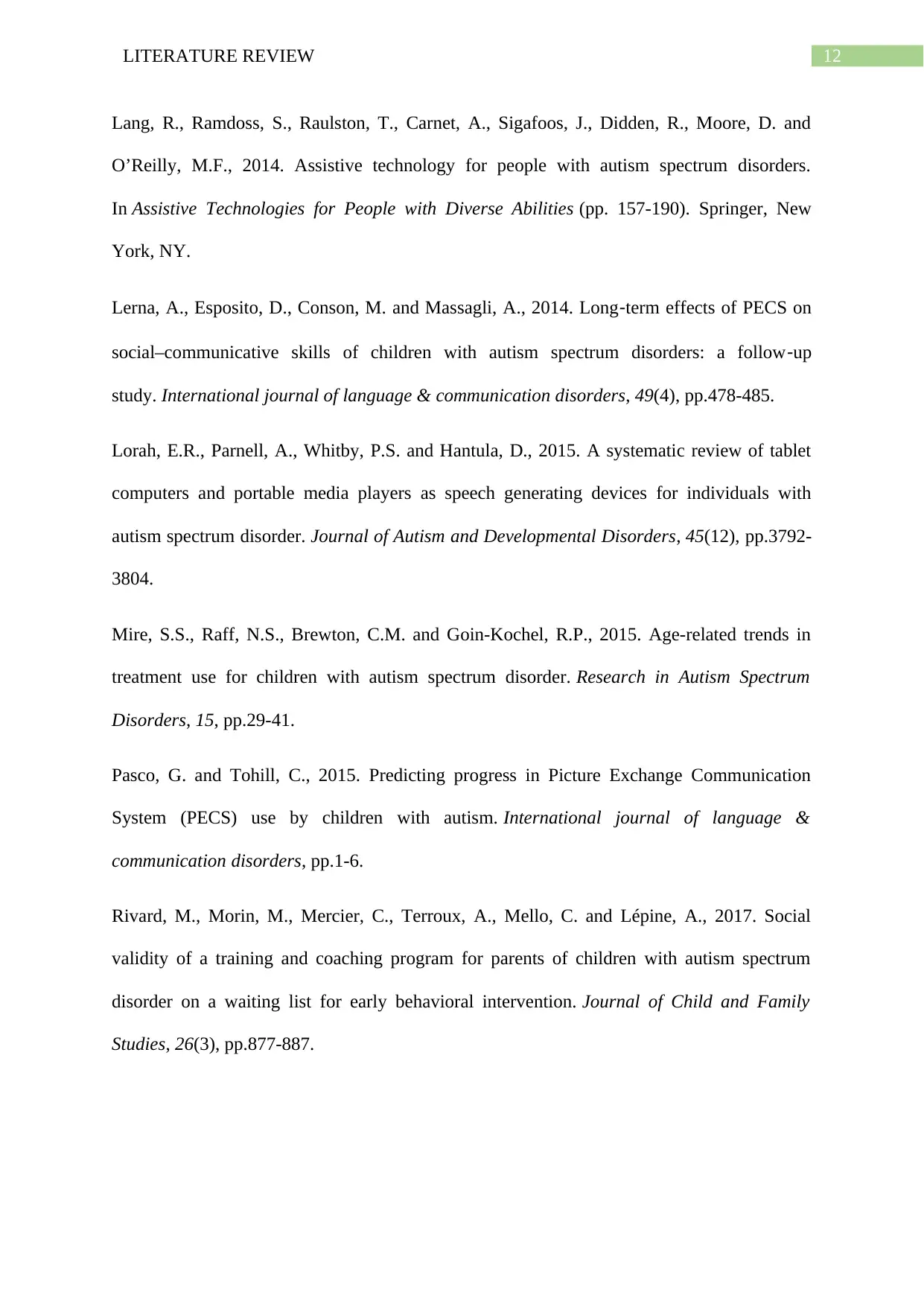
12LITERATURE REVIEW
Lang, R., Ramdoss, S., Raulston, T., Carnet, A., Sigafoos, J., Didden, R., Moore, D. and
O’Reilly, M.F., 2014. Assistive technology for people with autism spectrum disorders.
In Assistive Technologies for People with Diverse Abilities (pp. 157-190). Springer, New
York, NY.
Lerna, A., Esposito, D., Conson, M. and Massagli, A., 2014. Long‐term effects of PECS on
social–communicative skills of children with autism spectrum disorders: a follow‐up
study. International journal of language & communication disorders, 49(4), pp.478-485.
Lorah, E.R., Parnell, A., Whitby, P.S. and Hantula, D., 2015. A systematic review of tablet
computers and portable media players as speech generating devices for individuals with
autism spectrum disorder. Journal of Autism and Developmental Disorders, 45(12), pp.3792-
3804.
Mire, S.S., Raff, N.S., Brewton, C.M. and Goin-Kochel, R.P., 2015. Age-related trends in
treatment use for children with autism spectrum disorder. Research in Autism Spectrum
Disorders, 15, pp.29-41.
Pasco, G. and Tohill, C., 2015. Predicting progress in Picture Exchange Communication
System (PECS) use by children with autism. International journal of language &
communication disorders, pp.1-6.
Rivard, M., Morin, M., Mercier, C., Terroux, A., Mello, C. and Lépine, A., 2017. Social
validity of a training and coaching program for parents of children with autism spectrum
disorder on a waiting list for early behavioral intervention. Journal of Child and Family
Studies, 26(3), pp.877-887.
Lang, R., Ramdoss, S., Raulston, T., Carnet, A., Sigafoos, J., Didden, R., Moore, D. and
O’Reilly, M.F., 2014. Assistive technology for people with autism spectrum disorders.
In Assistive Technologies for People with Diverse Abilities (pp. 157-190). Springer, New
York, NY.
Lerna, A., Esposito, D., Conson, M. and Massagli, A., 2014. Long‐term effects of PECS on
social–communicative skills of children with autism spectrum disorders: a follow‐up
study. International journal of language & communication disorders, 49(4), pp.478-485.
Lorah, E.R., Parnell, A., Whitby, P.S. and Hantula, D., 2015. A systematic review of tablet
computers and portable media players as speech generating devices for individuals with
autism spectrum disorder. Journal of Autism and Developmental Disorders, 45(12), pp.3792-
3804.
Mire, S.S., Raff, N.S., Brewton, C.M. and Goin-Kochel, R.P., 2015. Age-related trends in
treatment use for children with autism spectrum disorder. Research in Autism Spectrum
Disorders, 15, pp.29-41.
Pasco, G. and Tohill, C., 2015. Predicting progress in Picture Exchange Communication
System (PECS) use by children with autism. International journal of language &
communication disorders, pp.1-6.
Rivard, M., Morin, M., Mercier, C., Terroux, A., Mello, C. and Lépine, A., 2017. Social
validity of a training and coaching program for parents of children with autism spectrum
disorder on a waiting list for early behavioral intervention. Journal of Child and Family
Studies, 26(3), pp.877-887.
⊘ This is a preview!⊘
Do you want full access?
Subscribe today to unlock all pages.

Trusted by 1+ million students worldwide
1 out of 13
Related Documents
Your All-in-One AI-Powered Toolkit for Academic Success.
+13062052269
info@desklib.com
Available 24*7 on WhatsApp / Email
![[object Object]](/_next/static/media/star-bottom.7253800d.svg)
Unlock your academic potential
Copyright © 2020–2025 A2Z Services. All Rights Reserved. Developed and managed by ZUCOL.





